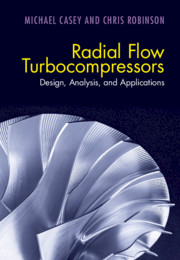Book contents
- Radial Flow Turbocompressors
- Radial Flow Turbocompressors
- Copyright page
- Dedication
- Contents
- Credits
- Introduction
- Preface
- Acknowledgements
- Conventions and Nomenclature
- 1 Introduction to Radial Flow Turbocompressors
- 2 Energy Transfer
- 3 Equations of State
- 4 Efficiency Definitions for Compressors
- 5 Fluid Mechanics
- 6 Gas Dynamics
- 7 Aerodynamic Loading
- 8 Similarity
- 9 Specific Speed
- 10 Losses and Performance
- 11 Impeller Design
- 12 Diffuser Design
- 13 Casing Component Design
- 14 Geometry Definition
- 15 Throughflow Code for Radial Compressors
- 16 Computational Fluid Dynamics
- 17 Compressor Instability and Control
- 18 Maps and Matching
- 19 Structural Integrity
- 20 Development and Testing
- References
- Index
16 - Computational Fluid Dynamics
Published online by Cambridge University Press: 08 July 2021
- Radial Flow Turbocompressors
- Radial Flow Turbocompressors
- Copyright page
- Dedication
- Contents
- Credits
- Introduction
- Preface
- Acknowledgements
- Conventions and Nomenclature
- 1 Introduction to Radial Flow Turbocompressors
- 2 Energy Transfer
- 3 Equations of State
- 4 Efficiency Definitions for Compressors
- 5 Fluid Mechanics
- 6 Gas Dynamics
- 7 Aerodynamic Loading
- 8 Similarity
- 9 Specific Speed
- 10 Losses and Performance
- 11 Impeller Design
- 12 Diffuser Design
- 13 Casing Component Design
- 14 Geometry Definition
- 15 Throughflow Code for Radial Compressors
- 16 Computational Fluid Dynamics
- 17 Compressor Instability and Control
- 18 Maps and Matching
- 19 Structural Integrity
- 20 Development and Testing
- References
- Index
Summary
Modern computational fluid dynamics (CFD) methods are described. CFD simulations of whole compressor stages using the Reynolds-averaged Navier–Stokes equations (RANS), with a steady-state rotor–stator interaction model between the blade rows and a two-equation turbulence model, are the basis of aerodynamic calculations for the design of radial compressors. More detailed simulations using unsteady RANS (URANS) equations with unsteady rotor–stator interaction models are now used in a research environment. The source of errors and the importance of validating the CFD methods are described. The prediction of the turbulent flow is one of the main error sources in CFD simulations, and an overview is given of turbulence models. Up-to-date guidelines are provided on the use of CFD for the design and development of components in radial turbocompressors. A practical description of the CFD process is given, including the technologies used to support the calculations, such as geometry generation, mesh generation and postprocessing.
Keywords
Information
- Type
- Chapter
- Information
- Radial Flow TurbocompressorsDesign, Analysis, and Applications, pp. 528 - 564Publisher: Cambridge University PressPrint publication year: 2021
